Polystyrene Coating on APTES-Primed Hydroxylated AA2024-T3: Characterization and Failure Mechanism of Corrosion
Abstract
:1. Introduction
2. Materials and Methods
2.1. Sample Preparation
2.2. Surface Characterization
2.3. Electrochemical Impedance Measurement
3. Results
3.1. Topographic Characterization of Coating
3.2. EIS Analysis Results
4. Failure Mechanisms
4.1. Mechanism 1—Coating Loses Impedance to Water Uptake in the Early Stage
4.2. Mechanism 2—Narrowing Passages in Porous Coating
4.3. Mechanism 3—Degraded Structural Integrity in Coating
4.4. Mechanism 4—Double-Layer Adsorption Predominates Charge Transfer
5. Conclusions
Funding
Data Availability Statement
Acknowledgments
Conflicts of Interest
References
- Románszki, L.; Datsenko, I.; May, Z.; Telegdi, J.; Nyikos, L.; Sand, W. Polystyrene films as barrier layers for corrosion protection of copper and copper alloys. Bioelectrochemistry 2014, 97, 7–14. [Google Scholar] [CrossRef] [PubMed]
- Peng, J.; Xing, R.; Wu, Y.; Li, B.; Han, Y.; Knoll, W.; Kim, D.H. Dewetting of thin polystyrene films under confinement. Langmuir 2007, 23, 2326–2329. [Google Scholar] [CrossRef] [PubMed]
- Zhang, J.; Zhang, L. Polystyrene/TiO2 Nanocomposite Coatings to Inhibit Corrosion of Aluminum Alloy 2024-T3. ACS Appl. Nano Mater. 2019, 2, 6368–6377. [Google Scholar] [CrossRef]
- Alangari, A.M.; Al Juhaiman, L.A.; Mekhamer, W.K. Enhanced Coating Protection of C-Steel Using Polystyrene Clay Nanocomposite Impregnated with Inhibitors. Polymers 2023, 15, 372. [Google Scholar] [CrossRef]
- Raju, A.; Lakshmi, V.; Prataap, R.V.; Resmi, V.; Rajan, T.; Pavithran, C.; Prasad, V.; Mohan, S. Adduct modified nano-clay mineral dispersed polystyrene nanocomposites as advanced corrosion resistance coatings for aluminum alloys. Appl. Clay Sci. 2016, 126, 81–88. [Google Scholar] [CrossRef]
- Amirshaqaqi, N.; Salami-Kalajahi, M.; Mahdavian, M. Corrosion behavior of aluminum/silica/polystyrene nanostructured hybrid flakes. Iran. Polym. J. 2014, 23, 699–706. [Google Scholar] [CrossRef]
- North, S.H.; Lock, E.H.; Cooper, C.J.; Franek, J.B.; Taitt, C.R.; Walton, S.G. Plasma-based surface modification of polystyrene microtiter plates for covalent immobilization of biomolecules. ACS Appl. Mater. Interfaces 2010, 2, 2884–2891. [Google Scholar] [CrossRef]
- Chen, C.-F.; Baart, B.V.; Zhang, J.; Zhang, L. Polystyrene/TiO2 nanocomposite coating for strength and toughness enhancement of aluminum alloy 2024-T3 in accelerated stress corrosion cracking. Prog. Org. Coat. 2021, 161, 106458. [Google Scholar] [CrossRef]
- Witucki, G.L. A Silane Primer: Chemistry and Applications of AIkoxy Silanes. J. Coat. Technol. 1993, 65, 57–60. [Google Scholar]
- Alghunaim, A.; Brink, E.T.; Newby, E.Y.; Newby, B.-M.Z.; Huttenlochner, K.; Müller-Renno, C.; Ziegler, C.; Merz, R.; Merz, B.; Kopnarski, M.; et al. Retention of poly (N-isopropylacrylamide) on 3-aminopropyltriethoxysilane. Biointerphases 2017, 12, 02C405. [Google Scholar] [CrossRef]
- Hintze, P.E.; Calle, L.M. Electrochemical properties and corrosion protection of organosilane self-assembled monolayers on aluminum 2024-T3. Electrochim. Acta 2006, 51, 1761–1766. [Google Scholar] [CrossRef]
- van Ooij, W.J.; Zhu, D.; Stacy, M.; Seth, A.; Mugada, T.; Gandhi, J.; Puomi, P. Corrosion protection properties of organofunctional silanes—An overview. Tsinghua Sci. Technol. 2005, 10, 639–664. [Google Scholar] [CrossRef]
- Smith, E.A.; Chen, W. How to prevent the loss of surface functionality derived from aminosilanes. Langmuir 2008, 24, 12405–12409. [Google Scholar] [CrossRef] [PubMed]
- Choi, S.-H.; Zhang Newby, B.-m. Suppress polystyrene thin film dewetting by modifying substrate surface with aminopropyltriethoxysilane. Surf. Sci. 2006, 600, 1391–1404. [Google Scholar] [CrossRef]
- Redon, C.; Brochard-Wyart, F.; Rondelez, F. Dynamics of dewetting. Phys. Rev. Lett. 1991, 66, 715. [Google Scholar] [CrossRef]
- Reiter, G. Unstable thin polymer films: Rupture and dewetting processes. Langmuir 2002, 9, 1344–1351. [Google Scholar] [CrossRef]
- Reiter, G. Dewetting of thin polymer films. Phys. Rev. Lett. 1992, 68, 75. [Google Scholar] [CrossRef]
- Reichlin, J.; Bormashenko, E.; Sheshnev, A.; Pogreb, R.; Shulzinger, E.; Katzir, A. Investigation of water penetration in polystyrene by use of polymer-coated AgClBr fibers and development of new sensor intended for the FEWS spectroscopy of organic compounds in water. In Proceedings of the SPIE—The International Society for Optical Engineering, San Diego, CA, USA, 30 July–4 August 2020; SPIE: Bellingham, WA, USA, 2000; pp. 305–313. [Google Scholar]
- van Westing, E.; Ferrari, G.; de Wit, J. The determination of coating performance with impedance measurements-I. Coating polymer properties. Coating polymer properties. Corros. Sci. 1993, 34, 1511–1530. [Google Scholar] [CrossRef]
- Brasher, D.M.; Kingsbury, A.H. Electrical measurements in the study of immersed paint coatings on metal. I. Comparison between capacitance and gravimetric methods of estimating water-uptake. J. Appl. Chem. 1954, 4, 62–72. [Google Scholar] [CrossRef]
- Sykes, J.M. A variant of the Brasher-Kingsbury equation. Corros. Sci. 2004, 46, 515–517. [Google Scholar] [CrossRef]
- Zhi, X.; Mao, Y.; Yu, Z.; Wen, S.; Li, Y.; Zhang, L.; Chan, T.W.; Liu, L. γ-Aminopropyl triethoxysilane functionalized graphene oxide for composites with high dielectric constant and low dielectric loss. Compos. Part A Appl. Sci. Manuf. 2015, 76, 194–202. [Google Scholar] [CrossRef]
- Margarit-Mattos, I.C.P.; Agura, F.A.R.; Silva, C.G.; Souza, W.A.; Quintela, J.P.; Solymossy, V. Electrochemical impedance aiding the selection of organic coatings for very aggressive conditions. Prog. Org. Coat. 2014, 77, 2012–2023. [Google Scholar] [CrossRef]
- Esser, P. Principles in adsorption to polystyrene. Thermo Sci. Nunc Bull. 1988, 6, 1–5. [Google Scholar]
- Etienne, M.; Walcarius, A. Analytical investigation of the chemical reactivity and stability of aminopropyl-grafted silica in aqueous medium. Talanta 2003, 59, 1173–1188. [Google Scholar] [CrossRef]
- Wang, G.; Yan, F.; Teng, Z.; Yang, W.; Li, T. The surface modification of silica with APTS. Prog. Chem. 2006, 18, 238. [Google Scholar]
- Howarter, J.; Youngblood, J. Optimization of silica silanization by 3-aminopropyltriethoxysilane. Langmuir 2006, 22, 11142–11147. [Google Scholar] [CrossRef]
- Zhang, C.-H.; Liu, M.; Jin, Y.; Sun, D.-B. The corrosive influence of chloride ions preference adsorption on α-Al2O3 (0 0 0 1) surface. Appl. Surf. Sci. 2015, 347, 386–391. [Google Scholar] [CrossRef]
- Sundar, A.; Chen, G.; Qi, L. Substitutional adsorptions of chloride at grain boundary sites on hydroxylated alumina surfaces initialize localized corrosion. Npj Mater. Degrad. 2021, 5, 18. [Google Scholar] [CrossRef]
- Oldham, K.B. A Gouy–Chapman–Stern model of the double layer at a (metal)/(ionic liquid) interface. J. Electroanal. Chem. 2008, 613, 131–138. [Google Scholar] [CrossRef]
- Salmeron, M.; Bluhm, H.; Tatarkhanov, M.; Ketteler, G.; Shimizu, T.K.; Mugarza, A.; Deng, X.; Herranz, T.; Yamamoto, S.; Nilsson, A. Water growth on metals and oxides: Binding, dissociation and role of hydroxyl groups. Faraday Discuss. 2008, 141, 221–229. [Google Scholar] [CrossRef]

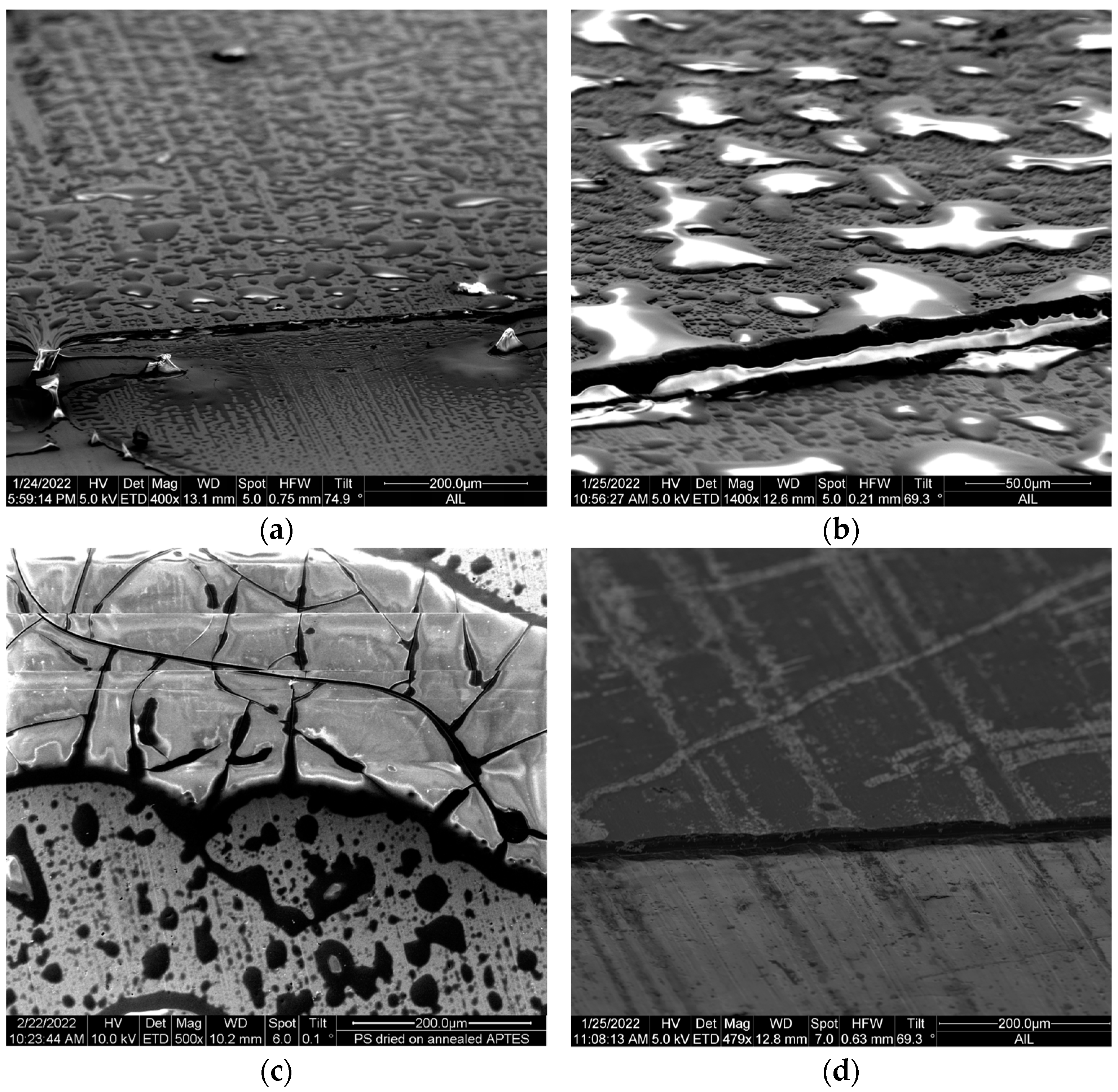

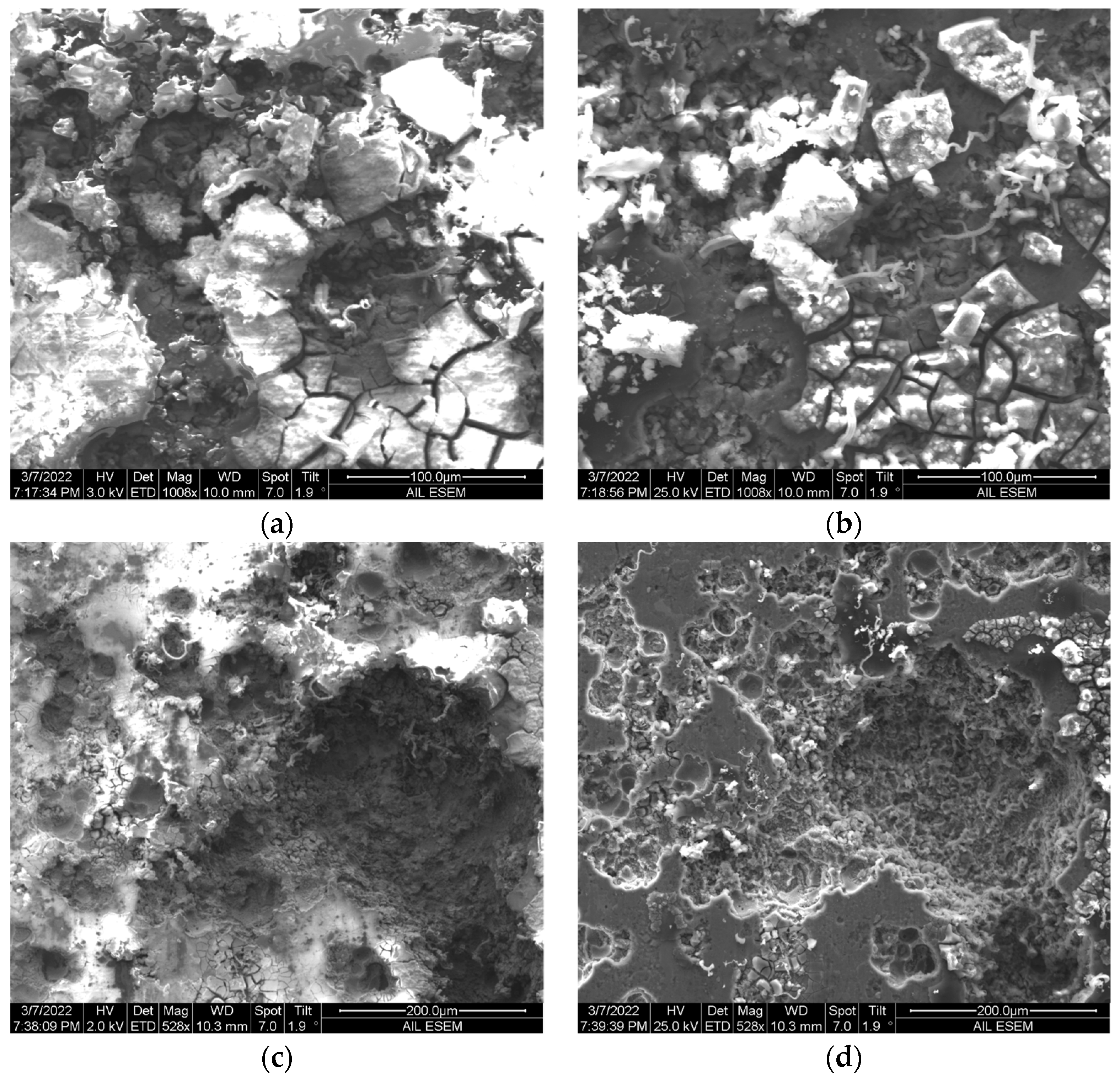
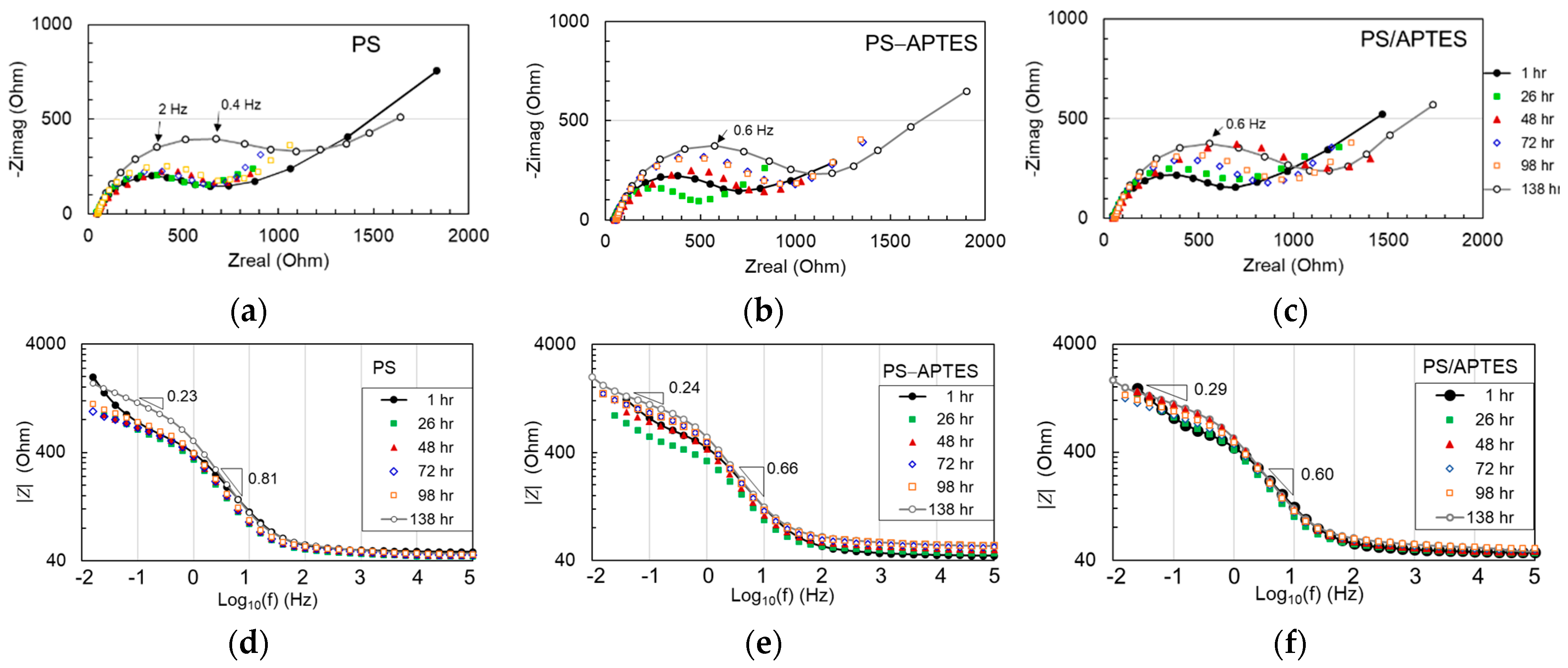

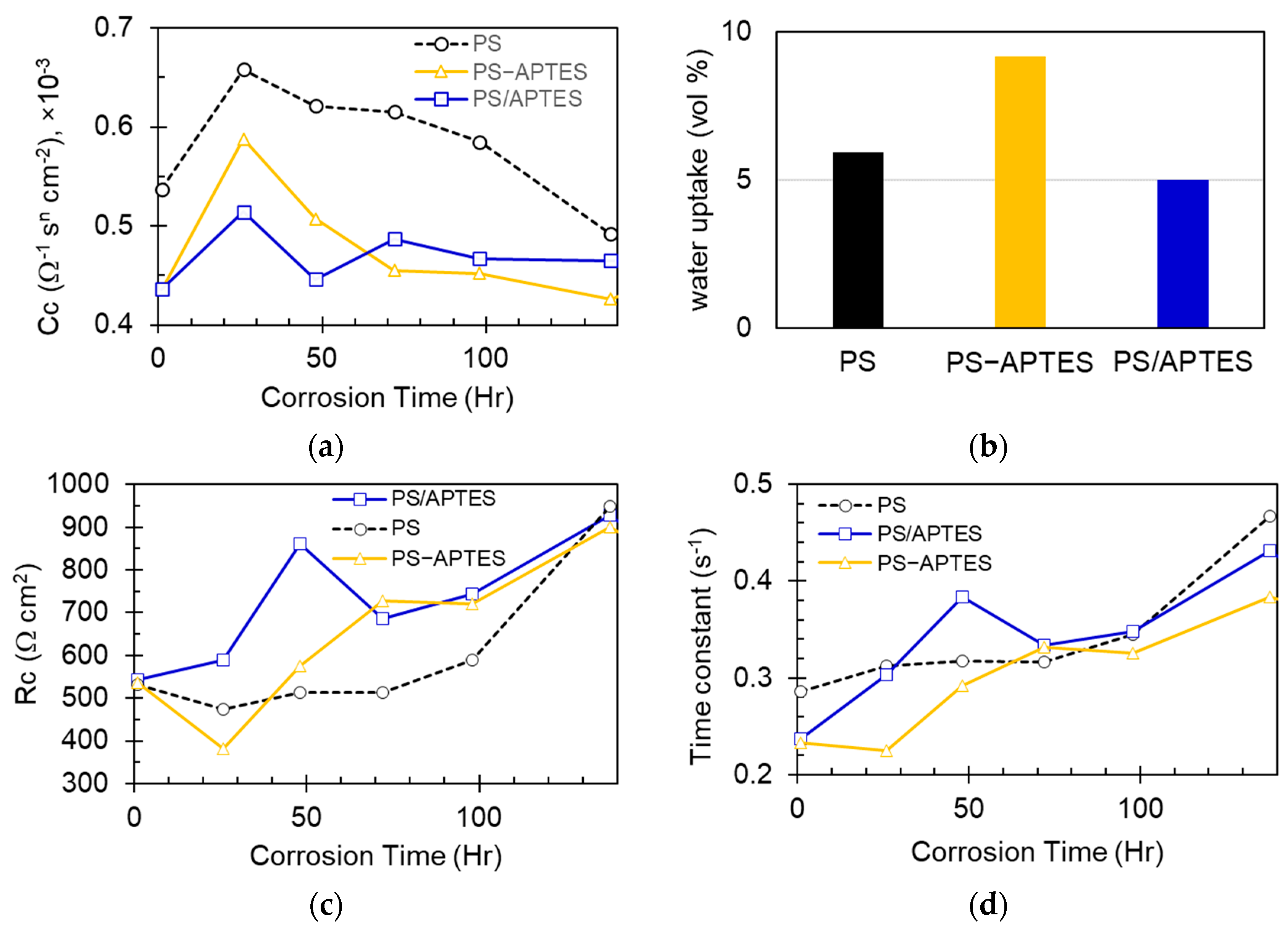
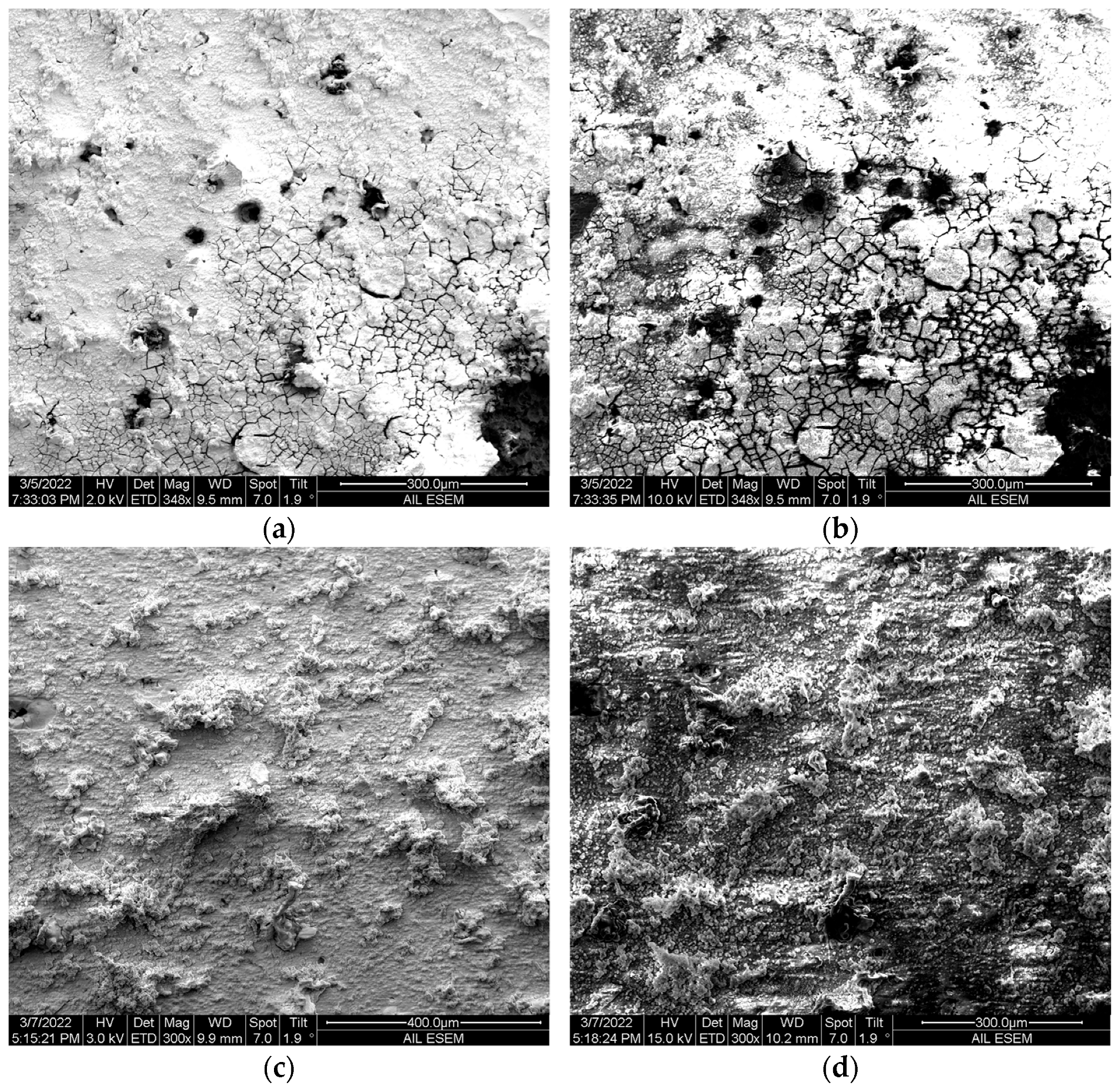
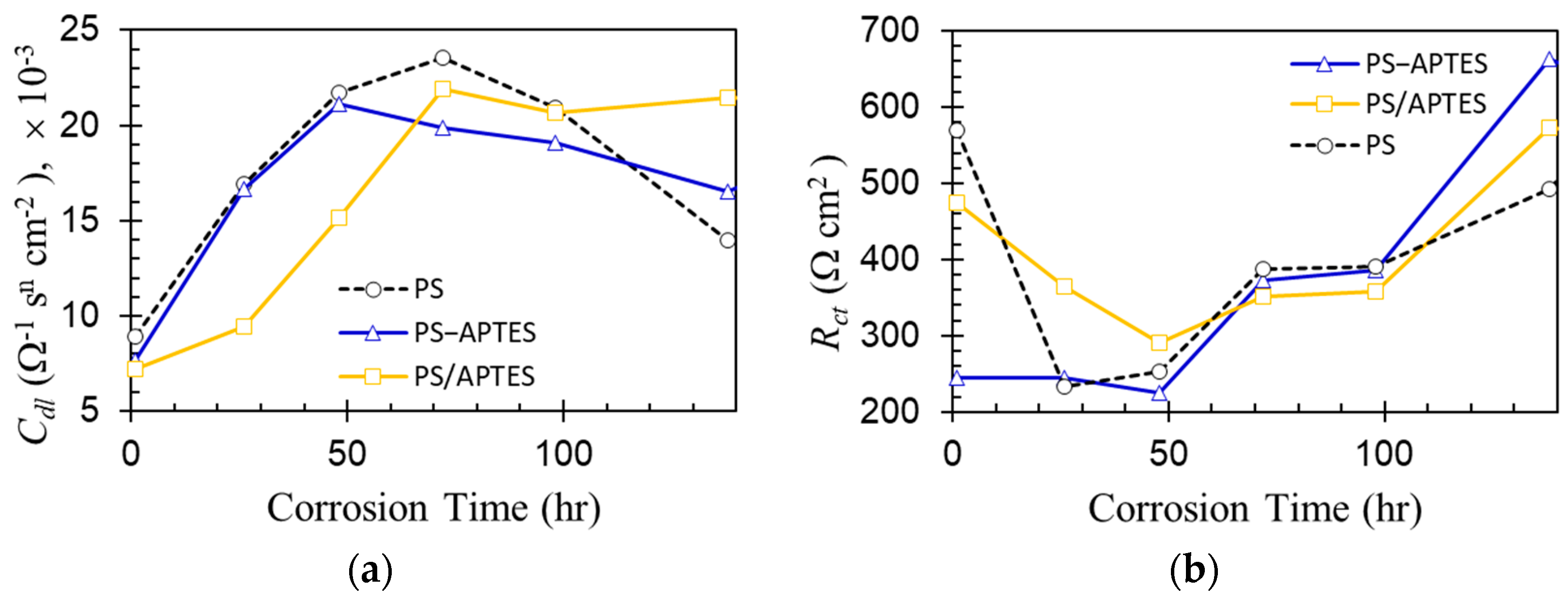
| Time (h) | Coating | Rs (Ω cm2) | Rc (Ω cm2) | Cc (Ω−1 sm cm−2) | m | Rct (Ω cm2) | Cdl (Ω−1 sn cm−2) | n | χ2 (×10−3) |
|---|---|---|---|---|---|---|---|---|---|
| 1 | PS | 38 | 532 | 5.37 × 10−4 | 0.82 | 569 | 8.92 × 10−3 | 1 | 12.8 |
| PS-APTES | 36 | 536 | 4.35 × 10−4 | 0.80 | 245 | 7.68 × 10−3 | 1 | 5.5 | |
| PS/APTES | 38 | 543 | 4.36 × 10−4 | 0.80 | 475 | 7.19 × 10−3 | 1 | 7.8 | |
| 26 | PS | 35 | 550 | 6.58 × 10−4 | 0.82 | 262 | 16.90 × 10−3 | 1 | 3.3 |
| PS-APTES | 38 | 382 | 5.88 × 10−4 | 0.82 | 245 | 16.64 × 10−3 | 1 | 4.8 | |
| PS/APTES | 38 | 590 | 5.14 × 10−4 | 0.83 | 253 | 9.43 × 10−3 | 1 | 4.8 | |
| 48 | PS | 37 | 512 | 6.21 × 10−4 | 0.83 | 253 | 21.72 × 10−3 | 1 | 3.7 |
| PS-APTES | 41 | 575 | 5.07 × 10−4 | 0.83 | 225 | 21.13 × 10−3 | 1 | 3.7 | |
| PS/APTES | 40 | 860 | 4.46 × 10−4 | 0.82 | 290 | 15.16 × 10−3 | 1 | 5.1 | |
| 72 | PS | 37 | 514 | 6.15 × 10−4 | 0.83 | 387 | 23.57 × 10−3 | 1 | 2.9 |
| PS-APTES | 43 | 728 | 4.55 × 10−4 | 0.83 | 373 | 19.86 × 10−3 | 1 | 4.4 | |
| PS/APTES | 42 | 686 | 4.87 × 10−4 | 0.82 | 351 | 21.92 × 10−3 | 1 | 4.7 | |
| 98 | PS | 38 | 589 | 5.85 × 10−4 | 0.82 | 390 | 20.95 × 10−3 | 1 | 3.0 |
| PS-APTES | 45 | 720 | 4.52 × 10−4 | 0.83 | 386 | 19.06 × 10−3 | 1 | 4.0 | |
| PS/APTES | 43 | 724 | 4.67 × 10−4 | 0.82 | 358 | 20.65 × 10−3 | 1 | 4.2 | |
| 138 | PS | 38 | 949 | 4.92 × 10−4 | 0.81 | 492 | 13.98 × 10−3 | 1 | 3.6 |
| PS-APTES | 45 | 900 | 4.26 × 10−4 | 0.82 | 663 | 16.50 × 10−3 | 1 | 4.7 | |
| PS/APTES | 41 | 927 | 4.65 × 10−4 | 0.80 | 573 | 21.43 × 10−3 | 1 | 9.6 |
Disclaimer/Publisher’s Note: The statements, opinions and data contained in all publications are solely those of the individual author(s) and contributor(s) and not of MDPI and/or the editor(s). MDPI and/or the editor(s) disclaim responsibility for any injury to people or property resulting from any ideas, methods, instructions or products referred to in the content. |
© 2023 by the author. Licensee MDPI, Basel, Switzerland. This article is an open access article distributed under the terms and conditions of the Creative Commons Attribution (CC BY) license (https://creativecommons.org/licenses/by/4.0/).
Share and Cite
Chen, C.-f. Polystyrene Coating on APTES-Primed Hydroxylated AA2024-T3: Characterization and Failure Mechanism of Corrosion. Solids 2023, 4, 254-267. https://doi.org/10.3390/solids4030016
Chen C-f. Polystyrene Coating on APTES-Primed Hydroxylated AA2024-T3: Characterization and Failure Mechanism of Corrosion. Solids. 2023; 4(3):254-267. https://doi.org/10.3390/solids4030016
Chicago/Turabian StyleChen, Cheng-fu. 2023. "Polystyrene Coating on APTES-Primed Hydroxylated AA2024-T3: Characterization and Failure Mechanism of Corrosion" Solids 4, no. 3: 254-267. https://doi.org/10.3390/solids4030016
APA StyleChen, C.-f. (2023). Polystyrene Coating on APTES-Primed Hydroxylated AA2024-T3: Characterization and Failure Mechanism of Corrosion. Solids, 4(3), 254-267. https://doi.org/10.3390/solids4030016







